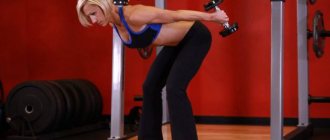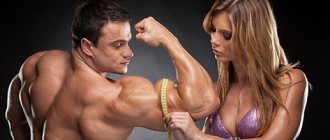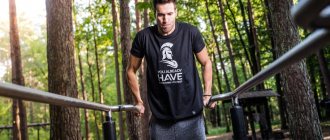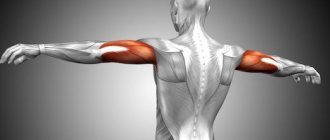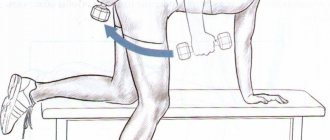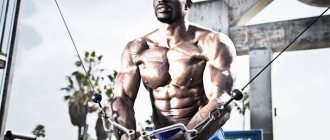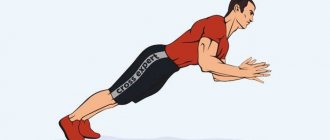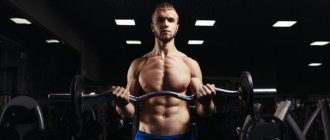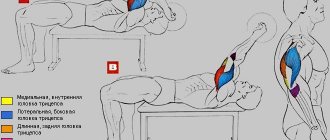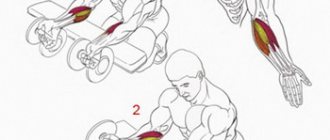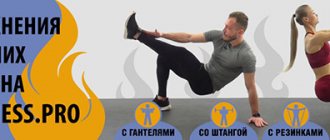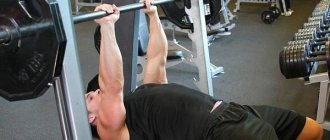Photo: Sport City store
Working muscles:
middle and upper back, back of shoulders
For what:
Traditionally, the wide handle is used for vertical rows, but with its help, triceps extensions, pullovers, horizontal back rows and biceps curls are excellent. The load can be adjusted using different types of grips, for which corresponding handles are made on the handle.
MN Council:
take the weight 10% less than with a straight handle - this way you will most effectively work your upper back.
Straight neck
Photo: Sport City store
Working muscles:
lower back, biceps
For what:
A straight horizontal bar is sure to be found even in the most seedy gym, and it is this that is the basis for many deadlifts. In addition, with a straight bar you can do almost all types of flexion and extension for the biceps and triceps.
MN Council:
a straight grip (with the back of your hand facing away from you) puts more strain on your back. Reverse grip - biceps, and in this case you can take 10-20% more weight.
What muscles work in the bench press on a block machine?
In the bench press in a block machine, the triceps receive the main load; it has three heads, which is why it is called the triceps brachii muscle. Most of the load goes to the medial head and lateral (side). But we can also use the third long head, just change the grip.
- Lateral head of the triceps. Located at the back of the side of the arm. Its good development will give the triceps an ideal shape, which is often represented in the form of a “horseshoe”; it will start working only if there is not enough effort at the medial head.
- Long head . Located behind, closer to the back, its task is to extend the elbow, so it participates in all triceps exercises, but takes a secondary part. She also fixes her hand near the body. This head is the largest and gives the hand the greatest massiveness.
- Medial head. Located in the upper back of the shoulder, it is the smallest among the three heads of the triceps, but at the same time it takes on the first load when extending the elbow.
Read more about the triceps muscles here
L-shaped handle
Photo: Sport City store
Working muscles:
upper back, biceps, triceps
For what:
horizontal and vertical rows, triceps extensions, biceps curls. But the design feature of this handle does not tie you to any one set of exercises, so you can experiment.
MN Council:
When starting to perform horizontal rows, take the weight with a perfectly straight back using the leg supports, rather than pulling it towards you with your back muscles.
Introduction
Initially, the handle is a means of transmitting force from the simulator to the athlete.
Not the source of effort, but precisely the means by which this effort is transmitted. This formulation also has the right to life due to the fact that different handles can be connected to one simulator, which will allow you to get different results. The simulator and handles can be viewed as a drill and replaceable drills, or as a mixer and various attachments for it, which ultimately allows you to get different results. Handles for rows are intended primarily for weight-block exercise machines, since, unlike other designs, as we already discussed in the article “Trainers and their purpose,” they have a cable and do not have built-in handles. Do not confuse the included ones with the built-in ones! Exercise machines equipped with a built-in block of plates have a cable, one end of which is attached to a movable carriage, which adjusts the weight using a key and lifts the plates. The other end of the cable forms a clamp on which the carabiner is attached, and the handles for the pulls are attached directly to the carabiner. Which ones exactly? Let's figure it out.
One-handed handle
Photo: Sport City store
Working muscles:
middle and upper back, shoulders, biceps
For what:
a single handle can be used either separately or in pairs with a second one - in this case, you can do crossover exercises for the chest muscles, biceps curls, and pump up your shoulders by raising your arms while bending over and standing. Well, there is no point in listing exercises for one hand - slightly fewer options are available than all the options.
MN Council:
use a single handle on exercise machines where you can perform exercises with each hand alternately. The main thing is to work only with your hand, do not push back or turn your body.
How to properly secure a climbing rope
This sports equipment requires little space. It can be mounted on the ceiling, a wooden beam, a metal crossbar, or simply on a thick tree branch. All that matters is the reliability of the load-bearing support and fastening system.
If your gym has fairly strong floors, you can secure the climbing rope using special ceiling brackets that have two, three or four attachment points for anchor bolts. Do not hang the sports equipment on an anchor hook or anchor ring under any circumstances, as such fasteners may be torn out or twisted from the support during training.
If there are reliable ceiling beams, it is better to fasten the rope fastening horizontally, in this case the load will act not on tearing out the fastener, but on breaking it. The most reliable would be a through fastening, in which the hook or loop passes completely through the beam and is secured with nuts on both sides.
To secure the simulator to a crossbar or branch, they usually use a simple-to-use, but at the same time reliable “Swiss conductor” knot. If you have a braided loop at the end of your climbing rope, you can simply wrap it around the branch and pass the end through it.
- Double hanker stainless steel bracket.
This type of fastening is recommended for products consisting of two ropes (ladders, swings). It can also be used on children's rope trainers.
- Three-anchor ceiling bracket made of stainless steel.
Suitable for almost any cable trainer. However, in sports clubs where the load on the machine is quite high, it is better to use a four-anchor bracket or splint.
- Ceiling bus.
It is a universal bracket that allows you to hang several rope trainers at once. It is available in two varieties - 950 mm (attached to five anchors) and 1430 mm (attached to seven anchors).
- Anchor hook, anchor ring.
Under no circumstances should you hang a climbing rope or rope from anchor hooks, as the anchor may unwind and fall out during use. Two anchor hooks can be used for hanging two-rope rope trainers (ladders, swings, horizontal bars). It is recommended to use anchors of at least M10 14x100 mm.
It is better to attach the hook to a wooden beam horizontally, so that the load is applied to breaking and not to tearing out.
- Fastening on the crossbar.
To secure the simulator to a reliable metal crossbar or tree branch, a “Swiss conductor” knot is usually used. If you have a braided loop at the end of your climbing rope, you can simply wrap it around the branch and pass the end through the loop.
The correct selection of fasteners is essential for the safe operation of a climbing rope. Brackets cannot be secured using conventional bolts/screws and plastic dowels. To choose a suitable anchor, you need to know exactly what material the ceiling (walls) are made of.
For a reinforced concrete monolith, standard expansion anchors of at least M8 10x100 mm are suitable. Hollow reinforced concrete slabs require the use of special anchors.
Chemical anchors will solve the problem of an insufficiently strong foundation.
You cannot hang a climbing rope from a plasterboard or plastic ceiling; in this case, mount the machine using wall brackets.
If you have doubts or questions, it is better to consult a specialist. And you shouldn’t opt for the cheapest anchors.
Bracket installation
If you have a hammer drill, a drill and appropriate experience, you can easily cope with attaching the brackets:
- It is necessary to attach the bracket to the place where it will be located and circle the holes with a pencil.
- Drill holes corresponding to the diameter and length of the anchors and clean them. Try on the bracket - the holes should match.
- The holes of two- and three-anchor brackets are smaller in size than the fastening part of the anchor (for greater reliability), so you first need to insert the anchors into the bracket, and then into the holes, tighten the bolts, applying sufficient force.
If you do not want to install the mounting system yourself, use the services of a specialist. You can control its operation in accordance with the instructions provided.
Climbing ropes can be attached to the bracket with a carabiner, a braided loop, or a knot, depending on your equipment.
V-shaped handle
Photo: Sportive store
Working muscles:
mid back
For what:
This handle, with wrist rests to prevent palms from slipping, is designed to work muscles from different angles. Very convenient for biceps curls in any position - even sitting, standing or even lying down, pullovers, triceps extensions.
MN Council:
When performing biceps curls while lying down, do not turn your elbows outward, but with your shoulders straight and parallel to the floor, pull the weight towards your stomach, then smoothly return the machine to its original position.
Cable Handle Cable Press
Initial position:
- Face the block.
- Firmly grasp the handle. The knuckles of both hands touch.
- Elbows are bent and pressed to the sides.
Performance:
- Slowly straighten your elbows, lowering the ends of the handle down and to the sides.
- At the lowest point of the amplitude, turn your hands with your little fingers up. Stay in this position for a second or two.
- Rotate your hands back and slowly return to the starting position.
Recommendations:
- With a cable handle, the downward press is more difficult to perform. You will have to reduce your normal working weight by at least a third.
- It is better to do the exercise with gloves, otherwise your palms will slide on the smooth surface of the rope.
STRAIGHT ARM PRESSES
Rope handle
Photo: ExFit store
Working muscles:
back of shoulders, upper back
For what:
pulling, flexion and extension - not only on the back, triceps or biceps, but also on the shoulders. There are a lot of exercise options, the main thing is proper weight adjustment.
MN Council:
A great way to pump up your abs is crunches called “prayer.” Attach the rope to the block frame. Get on your knees, squat slightly towards your heels and, holding the ropes with both hands, pull the load vertically down, but not with your hands, but by bending your body. In this case, the buttocks should remain at the same level.
Peculiarities
- The simulators must use special types of cables that correspond to the specific load.
Under the influence of the loads of the weight system and due to frequent bending when moving along the roller, the cable experiences heavy loads. For this reason, conventional cables sold for simple lifting of weights cannot withstand loads of this kind and quickly become unusable.
- Self-made block exercise machines that do not take into account the need to install cables on them that correspond to the characteristics of the load can be dangerous for trainees, especially with sudden, jerking movements used when trying to overcome heavy weights. This is especially true for a vertical traction machine.
- When operating such cables, high-quality crimping fittings that prevent them from twisting and the presence of internal lubrication are of great importance.
- Braiding helps protect the cable from damage caused by bending. The durability of the cable largely depends on its quality. A braid that is too rigid and does not bend well will quickly become unusable at the point of contact with the roller and lead to damage to the metal part of the cable.
- For safety reasons during operation, it is necessary to regularly inspect the cables, because Usually the cable does not break immediately, but after several small breaks in the threads. Particular attention should be paid to the sections of the cable in contact with the rollers.
- One of the causes of damage during operation may be improper fastening of the tip to the cable (at an angle). In this case, the tip can cut the cable with its sharp part. This aspect also needs to be paid attention to when purchasing.
According to modern safety requirements, the connection between the cable and the pulley in the simulator must be protected by a cover. This prevents dangerous contact with the user.
https://youtu.be/FIrsOQ4TlE0
EZ-handle
Photo: SportMir store
Working muscles:
biceps, triceps, shoulder muscles
For what:
The grip angle of this handle, probably familiar to you from the EZ barbell bar, allows you to relieve your wrists and perform flexions, extensions and pullovers without any harm to them. Keep in mind: the EZ-handle is not intended for any type of traction.
MN Council:
During biceps curls, only your forearms should move. Shoulders must remain unwavering!
The triceps extension on the upper block is a classic bodybuilding and fitness exercise. This is a common single-joint movement that is very popular due to its simplicity. But there are several technical nuances that allow you to feel the muscles being worked completely. Many people don't feel the triceps at all when they extend their elbows. They take too much weight and perform the exercise by swinging, due to inertia. These people should learn how to work in isolation and achieve their results faster. The movement is known with the classic straight and rope handle. The second option allows you to place more load on the lateral head of the muscle.
Initial position
- The movement starts from the point that many consider the middle of the amplitude. You need to start extending your arms from the “forearm parallel to the floor” position;
- You can take the correct position by standing at a distance of 30-40 cm from the crossover block;
- The handle should be grasped evenly, at the same distance from the center, with both hands;
- Bend slightly forward and slightly bend your knees;
- Take a breath, fix your abs;
- Reduce the shoulder blades to the spine and lower them to the pelvis;
- Keep your shoulders turned and in the same position
Movement
- As you exhale, you need to straighten your arms only at the elbow joints, leaving your shoulders stable;
- At the bottom point of the movement, you should linger, contracting your triceps;
- Then - return to the center of the amplitude and do not bend your elbows additionally in order to “push” the weight towards your shoulders;
- After completing the required number of repetitions, you need to return the projectile to its original position.
Attention
- The exercise is isolated - there is no need to “work” with your legs, body and abs;
- The more emphasis is placed on bending forward, the less stress the triceps receive;
- You cannot throw the weight in a negative phase; you need to smoothly lower it, as if “bringing it” with your muscles;
- You should control your elbows so that your forearms do not move too far from your body;
- The pace should be smooth and the same, there is no need to push the block down due to inertia and work in jerks
- The arms need to be extended exactly to the point where the tension is felt, but not overextended, “locking” the elbow;
- Do not bend your wrists so as not to overload the ligaments;
- It is better to keep brushes stiff;
- Block – keep suspended until the end of the exercise
Straight handle lat pulley press
Initial position:
- Stand facing the upper block, slightly bend your knees and lean forward slightly.
- Grasp the straight handle with an overhand grip.
- Elbows pressed to the body.
Performance:
- Keep your back straight and your shoulders back. Inhale powerfully and slowly straighten your elbows.
- At the lowest point of the amplitude, make a distinct pause. Additionally, statically tighten your triceps.
- Slowly return to the starting position.
Recommendations:
- Grab the handle with a shoulder-width grip. If the grip is narrow, the load on the triceps decreases.
- A straight handle puts stress on your wrists, so swap it out for a short curved or V-handle every once in a while for a workout or two.
Analysis of the exercise
Working muscles
The main mover is the triceps, the triceps brachii muscle. The good thing about a pulley exercise is that it uses all three heads.
Additional muscles and stabilizers – muscles of the core, forearms, deltoids, latissimus, pectoralis, hips as stabilizers
pros
- It is considered “aesthetic”, developing only appearance, but this is not so. In strength sports it is used as a kind of “cool-down” after a heavy bench or standing press. Allows you to recover faster, which means it affects strength indicators, albeit indirectly;
- Can be performed in a gentle way - without putting a lot of stress on the elbows, does not stretch the ligaments, like many other triceps exercises, and is suitable for rehabilitation after injuries if performed with light weight;
- If you attach a rubber band to the block, it will be an excellent warm-up exercise before a heavy bench press due to variable changes in the load;
- At the end of the workout, you can, again, work with rubber or light weights to “drive” blood into the muscles and ensure recovery
Minuses
- Not designed for strength work, is unlikely to build powerful triceps if the athlete does not press and does not work in a strength mode in other exercises
Content
- 1 Purpose of the exercise
- 2 Working muscles
- 3 Technique
https://youtu.be/3oc7GQXBmTI
Rope handle block pull for triceps
https://youtu.be/bT44gec-Myc
Rope handle block pull for triceps for girls
Triceps cable pull-down
In strength training, the triceps pull-down with a cable handle is used as an auxiliary exercise. The movement is actively used not only in bodybuilding and fitness, but also in powerlifting, being an important component of preparation for the bench press. There are several technical versions of this exercise and several nuances to its implementation.
Preparation for execution
Many people need to “mentally prepare” so as not to immediately take on the maximum weight. It’s impossible to hit anyone with this, but it’s easy to injure your shoulders. If you need to stand in front of the block with your shoulders rounded forward, the weight is too heavy, you need to take fewer tiles.
This exercise usually ends a bencher's or bodybuilder's workout. If used as a warm-up exercise, it is performed with rubber, or with minimal weight. When working the triceps in isolation with just this exercise (for example, during rehabilitation or in a program for a beginner), you need to warm up the joints before you start moving. Then – work with minimal weight.
Buying a cable
Where can I buy
You can buy a cable on the websites of many companies on the Internet or in sports equipment stores. Sometimes ready-made cables are sold, but purchasing them to order usually does not take much time, because The cables take approximately 40 minutes to prepare.
What is the price
The cable can be purchased in coils, in lengths, or ready-made with the desired type of end. Cable 35 will cost approximately 220-300 rubles per meter. Cable 46 will cost a little less. Prices for finished cables will differ depending on the type of tip and total length. They are usually clarified over the phone. Prices for tips vary from 150 to 450 rubles.
Naturally, if you buy in bulk, the cost will be significantly lower. The original cable from the manufacturer of the exercise machine will cost more. A cable for a ministepper will cost 500 rubles.
Proper execution
- Bodybuilding reference books often say that an athlete should work with an extremely straight back and avoid bending forward. This is not entirely correct, a slight tilt is allowed, about 15 degrees. The movement should not be performed entirely by leaning and inertia;
- Elbows should not “walk” sideways and forward, or back and forth;
- A technical trick that allows you to perform the movement with the correct body position - gaze directed straight ahead;
- There is no point in starting from the front deltoids; in this position the biceps work more than the triceps in the exercise. You should not perform the movement using muscles that are not targeted by the exercise;
- The correct starting point is forearms parallel to the floor. The use of this technique does not allow you to lift heavy weights, and indirectly protects against ligament injuries;
- When using a rope handle, you need to monitor the position of your fingers; they should not seem to “huddle together”; the grip should be evenly distributed;
- When using a straight handle, control the wrists; their excessive extension or flexion is a technical error;
- Exhalation is carried out with effort, synchronization of extensions with breathing allows you to control the movement and helps to hold the body quite actively;
- Looking straight ahead will help keep your head in the correct position. You need to look forward, and not tilt your head to the side, so that the cable passes through the side.
- Working with elbows “protruding” in different directions;
- A sharp, short body bend forward to help push the weight;
- Quick relaxation of the triceps after straightening the arms, “bouncing” the weight to the starting position by inertia;
- Full lowering of the weight, contact of the tiles with each other;
- Rolling the shoulders forward to create additional leverage;
- Walking out onto your toes, changing the position of your legs;
- Work in the shoulder joints and hands, which allows you to move the weight from a dead point
- To involve the triceps in the work, use a rope handle or attach rubber to the upper block evenly. This version of the exercise does not allow you to perform it with heavy weights, but this is not necessary. The straight handle helps to lock the hands more and perform the movement more isolated;
- A short pause at the lower permissible part of the amplitude will help to work the triceps more efficiently without using weights that are traumatic for joints and ligaments. In this case, there is no need to “press” and “insert your elbows” until it clicks;
- A “scissors” stance, when one leg is placed in front of the other, will help to actively engage the triceps in the work, if a person does not bend over like that, and stands stably, preventing the body from “working extra” and pushing the weight down due to inertia. Stepping is not a technical error, but rather a technique that helps some athletes;
- You can use a rigid handle to handle more weight. This makes sense if you bench press and need additional strength work after the main one. For beginners and those who train triceps in pump mode, it is better to use a cable handle for now;
- If your back gets tired during an exercise, it makes sense to change your legs;
- To maintain a smooth pace, you should do the exercise in a concentrated style, slowly extending your elbows for 2-3 counts;
- The exercise, when the elbows are extended from behind the head, significantly involves the shoulder joint in the work, and therefore is more difficult. It is demanding on the athlete's flexibility. If your shoulders are not very good yet, you should abandon this variation of the exercise.
Many people warm up with this movement. Of course, we are talking about the bench press. If we do the same, it is worth remembering the rules. To begin with, a joint warm-up and a couple of sets of extensions with light rubber. Then - 1-2 approaches with minimal block resistance. Those intending to bench press do not need to do high-rep pump sets in order to “work the triceps in advance.” This approach does not work well if a person really cares about results in the main exercise and healthy elbows. The purpose of the warm-up is to increase the local temperature of the muscles, improve blood supply and prepare for the main movement, and not to tire the muscles so that extension becomes completely impossible.
- With the help of this accessory you can achieve an expressive relief of the muscles being worked. And, as you know, the powerful triceps is the most noticeable muscle, making up 2/3 of the entire arm and being the main sign of an athletic physique
- Traction exercises will be appropriate in a set of exercises of any intensity. A weightlifter of any weight category can choose the optimal load for himself by varying the number of approaches and repetitions.
The advantages of any triceps pull-down handle from our catalog:
- The basis of the products is durable chrome-plated steel. The handles of most models are made of soft rubber, which ensures ease of use of the simulator.
- The products are lightweight, so they are easy to transport from home to the gym
- Designed for increased loads
- Accompanied by a quality guarantee from the manufacturer
Also in our online store you can purchase multifunctional handles that allow you to work not only the triceps, but also other muscle groups. For example, delta, biceps and abdominal muscles. Such a machine is a real must-have not only for professional weightlifters, but also for all people who want to shape the athletic profile of their body. You can purchase the handle with either a single or double grip. Both short and long. In addition to steel models, the range includes traction in the form of nylon ropes equipped with metal loops for coupling to the machine, and nylon belts. Despite their soft texture, they are almost as strong as their steel counterparts. The main difference between models of traction handles is the type of grip: some athletes find it more convenient to hold on to the rubberized handles, while others prefer to hold on to the straps.
Today, athletes are increasingly using complex machines to strengthen their arms, and training triceps on a block has become a very popular activity. The triceps is the triceps muscle on the back of the arm, connecting the shoulder joint to the elbow, as well as to the shoulder blade. This muscle consists of three bundles (or heads): lateral, medial and long. The triceps perform the function of extending the arms at the elbow joints in the body.
The main and basic exercises for the development of this muscle are, in fact, all kinds of arm extensions - with a straight or curved barbell, with dumbbells. However, you can and should also add triceps extensions on a block to them - exercises of this nature will help to greatly enhance the effect of the basic ones. After all, they allow you to achieve an even higher degree of load isolation.
Pumping up the triceps muscle on a block simulator, in any variation, is precisely an isolating exercise. This forces the lateral and medial triceps to work. The internal (long) beam is practically not loaded during training on the block. Unless you grab the handle with a reverse grip. But the classic technique of performing exercises on a block involves just a regular grip, from above.
After attaching one of the handles to the block and setting the desired weight, you need to take the handle with a direct grip, choosing the most comfortable hand position. The main thing is that the grip should not be wide, but at a level slightly narrower than shoulder width.
When performing the triceps extension itself, you need to make sure that your elbows are pressed to your sides and motionless during each movement. The back should be straight. The body can be slightly tilted forward, but without rounding the back or hunching the shoulders.
When performing extensions, your legs can be kept straight, or better yet, slightly bent at the knee joints. It is also allowed to put one leg slightly forward (i.e., so that your feet are not at the same level). Here you just need to experiment and choose the position of your legs that will be the most stable and comfortable for you.
When the hands with the handle are in the highest position, we inhale. And as we straighten our arms, we exhale with effort. At the final lowest point of extension, it makes sense to take a short (second) pause in order to feel the peak contraction of the muscle. Your arms must be straightened completely. So that the handle touches the upper thighs.
But at the top point, the hands with the handle should not be brought to the end a little, to their highest state. Because the muscles there are already relaxing, and the load is removed from them. For high-quality training, we need to ensure a constant load throughout the entire exercise. All movements should be slow, rhythmic and controlled.
If you follow all these subtleties of the correct technique, you will feel that it is your triceps that are clogged, and other muscle groups are not included in the work at all. With the exception of the muscles of the forearm, which play an auxiliary and supporting role in extensions on the block.
When performing triceps extensions on the upper block, you can and should use all the handles for the block machine that are available in your fitness room. Small changes in grip, which are provided by the use of different types of handles, will help to work the triceps muscle from different angles.
For example, a V-shaped handle targets the outer part of the triceps, while a straight bar puts stress on the long heads of the triceps. According to many athletes, the cable handle provides the deepest pumping of the triceps. It allows you to “reach” the deepest muscle fibers of the triceps muscle.
Whatever type of handle you choose, in any case, classic triceps extensions imply pulling only from the upper block. This exercise is performed standing. The legs, slightly bent at the knees, are positioned shoulder-width apart (or one leg is slightly extended, as if taking half a step forward, for greater stability).
Perform arm extensions on a block so that only the elbow joint is working. To do this, the elbows must be motionless, fixed in a position pressed close to the body. Under no circumstances should you turn extensions into presses!
The classic and absolutely correct execution of this exercise does not imply any forward bending of the body. Because the more the athlete leans forward, the more he will (voluntarily or not) help his triceps with the weight of his own body. And this already removes a significant part of the load from the muscle being worked. You only need to use the strength of the triceps, and nothing more.
To change the nature of the load and just for variety, when performing exercises for triceps extension in a block, you should pay special attention to the rope handle. That is, in addition to extensions using metal handles, you also need to include exercises with ropes or special straps in your training.
This equipment allows you to stretch your triceps harder. The amplitude of movements will become close to maximum if you extend your arms not just down, but down/to the sides (spreading them apart at the lowest point). This way, it will be more difficult to perform the exercise with proper technique, so you need to choose less weight.
It is important to allow the cable with a rope handle to perform the greatest range of motion when performing biceps extensions in the upper block, remembering to “catch” a second pause in the lower position of the arms to ensure peak muscle contraction.
It is not without reason that the variety of arm extensions with a rope handle of the upper block is considered the most effective by many experienced athletes. After all, the rope handle provides very high-quality isolated work and exceptionally strong contraction of the triceps, with a predominant load on their lateral bundles.
Another highly effective way to work the triceps in a standing block is to perform arm extensions with a curved handle. The curved metal handle facilitates partial rotation of the hands: the right hand – clockwise, and the left hand – counterclockwise. In this situation, the main part of the load falls on the outer heads of the triceps.
This exercise is also performed while standing. The torso is not necessarily held in a strictly vertical position during this triceps pulley movement. To balance the stand, you can slightly tilt your body forward. Also, to maintain the correct body position, you must not change the direction of your gaze: always look straight ahead.
With the correct technique for performing this exercise, the arms from shoulder to elbow are strictly perpendicular to the floor. This position does not need to be changed when straightening your arms. This way you can achieve the best development of all the muscle fibers of the long head of the triceps. When lowering the palms turned to the sides downwards, a powerful contraction of the medial fascicles of the triceps occurs (with an ordinary straight grip, extension of the arms is carried out by contraction of the long fascicles).
Don't overdo it with the weight load. If you overdo it with weight, then part of the load will inevitably transfer to other muscle groups, which will also be involved in the work. And this completely defeats the purpose of this triceps exercise.
Pullover in crossover trainer with rope handle
The exercise is aimed at strengthening the upper back and focuses on the middle part of the latissimus muscles.
The work includes the trapezius muscles, rear delta and biceps. When performing the exercise, we bring the shoulder blades together. When we pull down, exhale, when lowering to the starting position, exhale. We perform 3 sets of 15-20 repetitions. The load is focused on the trapezius and rhomboid muscles of the back. When pulling towards the belt, exhale, when lowering, inhale. We perform the movement smoothly and under control. Don't forget to squeeze your shoulder blades together. We perform 3 sets of 15-20 repetitions.
https://youtu.be/Ri-eNgL3Zbg
The purpose of the exercise is to work the middle of the back and emphasize the load on the rear deltoids. We do 3 sets of 15-20 repetitions. When pulling towards the chest, we exhale, and when lowering, inhale.
The exercise engages the lower part of the latissimus dorsi muscles. We do 3 sets of 15-20 repetitions. We remember that you need to bring your shoulder blades together.
The cable pulldown is a great exercise for the rear deltoids, trapezius, and upper back muscles.
Strong shoulders are very important for everyday activities of lifting, pressing, pulling and rotating the arms. The deltoid muscle is a powerful group of shoulder muscles responsible for all overhead activities (placing objects on high shelves, lifting a child on your shoulders, or even playing basketball).
The deltoids have three separate heads - anterior, lateral and posterior. The anterior and lateral heads of the deltoid often work much harder than the rear deltoids because they are involved in pushing and pressing exercises. The rear delts, in comparison, are often neglected. This type of muscle imbalance can contribute to shoulder pain and injury, not to mention a hunched over appearance and poor posture. As a result, it is important to include exercises that target the rear delts in your program.
Often, most lovers of strength training neglect the classic pullover due to the complexity of the technique and its specifics, because the effectiveness of the exercise lies in the maximum stretching of the pectoral muscles and triceps. A standing pullover, on the contrary, does not stretch the pectoral muscles and triceps, as when placing a dumbbell behind the head; the technique is clearer and more accessible due to the anatomy of the exercise, or rather, the option is simpler for most trainees.
Thus, straight-arm overhead pull-downs are more suitable for those who want to pay special attention to their back, and for those for whom a lying pullover causes discomfort and pain.
In addition, a pullover in a crossover is safer and less traumatic. If the free weight of the dumbbell cannot be held and the muscles are severely stretched, then in the version with the upper block, when muscle “failure” occurs, the athlete only needs to return the plates to their place by lifting the arms higher than the top point of the amplitude. In this case, there is no way to drop the weight on yourself or stretch the ligaments, unless, of course, you make a jerk, which is extremely prohibited with any weight.
This option is made with a straight handle. If this grip causes pain, you can change to a curved handle that provides a neutral grip. Let's consider the option of performing it in a crossover, but the exercise can also be performed in a vertical block for the back muscles.
- Place your hands on the handles, shoulder-width apart, with an overhand grip, and place your feet hip-width apart.
- Move back a little from the block, tensioning the cable. Your arms should be straight throughout the entire approach. At the beginning of the movement, the hands should be at shoulder level or slightly above, but do not raise them too high, as you need to maintain constant tension in the back, and not switch to the chest and arms.
- The back should remain vertical, with the exception of the lower back, which should be slightly arched, pushing the pelvis back, but the thoracic region should remain flat. This position ensures constant tension in the latissimus dorsi muscles. It is a mistake to lean too far forward, since the emphasis from the back will shift to the pectoral muscles and triceps. The more vertical the position, the more the lats are loaded.
- The knees should be slightly bent, this will allow you to maintain the arch in the lower back without difficulty and concentrate the load on the back muscles.
- Inhale, and as you exhale, lower the handle with your straight arms down, touching your hips. Additionally, do not bend over, round your chest, or rock. Do not bend your elbows so as not to engage the shoulder muscles. The chest should be open and stretch upward.
- As you inhale, smoothly return your arms up to shoulder or chin level, but not higher.
We suggest you familiarize yourself with How to make an enema yourself at home.
There are some physiological features that require a slight change in technique.
- For example, tall people should step back more or perform the exercise from their knees.
- Also, the position of the back can be determined by the response of the muscles, for example, an athlete in a vertical position does not feel the work of the back muscles and pulls the block more with his hands, but in a slight tilt he begins to feel the work of the back muscles more strongly.
- The same applies to the choice of handles - it is important to monitor your own feelings, because everyone’s body structure is different.
To perform this movement, you will need a crossover machine - a block-type power structure, available in almost all gyms. Extension is done on the upper block.
The main work in this exercise is performed by the triceps - the brachial muscle formed by three bundles: long, lateral and medial. It anatomically passes into a tendon that attaches to the olecranon process of the ulna. The task of the triceps muscle is to extend the forearm at the elbow joint. The long head of the triceps helps drive the shoulder joint.
The triceps accounts for approximately 2/3 of the muscle volume of the shoulder, so this muscle directly affects the definition of the arms.
Static load in extension is received by:
- back muscles (latissimus, teres major, spinal extensors);
- posterior deltoid bundles;
- pectoral muscles;
- lower trapezius area;
- abdominal muscles;
- wrist flexors.
Vertical cable extensions activate all 3 heads of the triceps.
This exercise is isolating because it involves one joint - the elbow. In this regard, it is not recommended to use large weights here: single-joint load distribution leads to distortion of the technique and increases the risk of injury.
An exercise on a vertical block, performed after training with free weights, creates a concentrated load on the triceps, helping to clearly define the muscle relief.
V
The movement on the block is carried out along a given trajectory downwards, which allows you to feel the contraction of the triceps muscle as much as possible.
Extensions can be done in a variety of ways, changing the handles and experimenting with different types of grips. This will allow you to work the target muscles from different angles and avoid a training plateau.
Working out the triceps in a crossover is a suitable option for girls who do not aim to build muscle mass and who want to keep the muscles of the upper arms in good shape.
V
Before you begin extensions, you need to decide on the choice of handle.
To work the triceps, a short straight handle is often used. With it you can practice with a direct and reverse narrow grip.
To work the triceps on the block, a short straight handle is often used
If there is no short handle in the gym, it is permissible to do extensions with a wide handle - it is usually used for training the back on a vertical block.
Working on the triceps with a wide handle is less convenient, however
For a comfortable position of the hands, it is convenient to use the V-shaped handle.
V-shaped handle allows you to work on the triceps in a comfortable position
Working with a curved handle allows you to position your hands in a special way: the right one in a clockwise direction, and the left one in the opposite direction. In this case, the emphasis of the load will shift to the outer triceps bundle. In addition, the curves on the handle create a more comfortable position for the elbows and reduce stress on this area.
V
You can effectively work the triceps muscle using a rope handle. Here you will have to practice with a neutral grip, so the load on your elbows will be minimal.
According to many athletes, the cable handle works the triceps the best.
If an athlete prefers to perform extensions with each arm in turn, a D-shaped handle will suit him.
V
Not every gym has all the listed types of handles, but the variability of the exercise in question allows you to practice with the equipment that is available: this will not make your training any less effective.
You can perform triceps extensions both in a block frame and in a vertical block, traditionally used for back training. The second option is less comfortable for working on the triceps, since the handle in it is fixed high, and there is no possibility of adjusting the height.
We suggest that you familiarize yourself with the Upper pectoral muscles exercises
Before starting the lesson, select the desired handle, attach it to the upper block and determine the working weight.
The basic version of triceps extensions is considered to be training using a straight handle, which is taken with a straight (overhead) grip slightly narrower than shoulder width. This grip will allow you to effectively work out the medial and lateral heads of the triceps muscle.
Positioned facing the device, take the handle and lower it until a right angle is formed between the shoulder and forearm. The body is kept level, slightly tilted forward, with a fixed natural arch in the back. One foot can be placed slightly in front of the other for greater stability. The chest is straightened, the elbows are kept in close proximity to the body.
- Inhaling, with a uniform force of the triceps, move the handle to the bottom until the arms are completely straightened. The most difficult part of the movement is done while exhaling. Only your forearms should move.
- At the lowest point, the handle almost touches the hips. Here they stop for 1–2 seconds, further contracting the muscles being worked.
- With a controlled and slow movement, resisting inertia, while inhaling we go up to the original position.
Do 15 times in 3 approaches.
V
Unlike the “classics”, here the handle is taken with an underhand grip. This method is used if you need to shift the emphasis of the load to the long head of the triceps.
- Stand facing the top block.
- Firmly grasp the V-handle, bend your knees slightly and lean forward slightly.
- Elbows pressed to the body.
- Keeping your elbows strictly motionless, straighten your arms.
- Extend your arms completely, feeling the tension in your triceps.
- Slowly return to the starting position (handle at chest level).
- Keep your back straight and pull your shoulders back
- Do not slouch or lean your body weight on the handle. The whole exercise comes down to isolated extension-flexion of the elbows. Corps assistance is excluded.
- It is extremely effective to perform the last set of this exercise as a drop set. It's done like this. First, do all the repetitions in the set, then reduce the load by exactly half and perform as many more repetitions as you can until you are completely exhausted.
- Stand facing the upper block, slightly bend your knees and lean forward slightly.
- Grasp the straight handle with an overhand grip.
- Elbows pressed to the body.
- Keep your back straight and your shoulders back. Inhale powerfully and slowly straighten your elbows.
- At the lowest point of the amplitude, make a distinct pause. Additionally, statically tighten your triceps.
- Slowly return to the starting position.
- Grab the handle with a shoulder-width grip. If the grip is narrow, the load on the triceps decreases.
- A straight handle puts stress on your wrists, so swap it out for a short curved or V-handle every once in a while for a workout or two.
- Face the block.
- Firmly grasp the handle. The knuckles of both hands touch.
- Elbows are bent and pressed to the sides.
- Slowly straighten your elbows, lowering the ends of the handle down and to the sides.
- At the lowest point of the amplitude, turn your hands with your little fingers up. Stay in this position for a second or two.
- Rotate your hands back and slowly return to the starting position.
- With a cable handle, the downward press is more difficult to perform. You will have to reduce your normal working weight by at least a third.
- It is better to do the exercise with gloves, otherwise your palms will slide on the smooth surface of the rope.
- All variations of presses are suitable for opening triceps training. Presses warm up the elbow joints well without overloading them. After bench presses, you can safely move on to complex exercises such as standing and lying French presses. By the way, it is worth completing the training of the triceps with bench presses in order to bring them to the point of complete “switching off”. For final presses, a cable handle is more suitable.
- If you are going to train your triceps in the same workout as your pecs or deltoids, first deal with these muscles, and only then tackle the triceps. The fact is that the pectorals and deltoids work together with the triceps in all exercises. Tired triceps will not allow you to load them to their full potential.
- For the same reason, do not train your pecs and deltoids the day after training your triceps. During the night, the triceps will not be able to recover, and the exercises on the pectoral and deltoids will be half-hearted.
- To ensure that all triceps bundles receive their portion of the load, regularly change the handles when performing downward presses.
- If you really don't have time, do two sets of cable, straight, and V-handle presses. This is enough to maintain high triceps tone.
We invite you to familiarize yourself with the Diet of Ekaterina Mirimanova - System Minus 60
Other arm extension options
It makes sense to try doing triceps block raises in other ways. And don’t just try, but include the following exercises in your regular training program:
One-arm reverse triceps extension
This exercise is more technically difficult. However, when performed correctly, it provides the opportunity to focus the load specifically on the lateral fascicle of the triceps muscle. In all other exercises, this part of the triceps is not involved at all. Perform reverse grip extensions immediately after classic arm extensions, ensuring maximum range of motion. Then the triceps will be worked out most harmoniously. This exercise is recommended for experienced athletes; beginners should not waste time on it yet.
This is a kind of analogue of a single arm extension with a dumbbell - overhead press - while sitting. Here, too, the work is done on the lower, and not on the upper block. You need to place a bench next to the block simulator “frame”, sit with your back to the simulator, raise your arm and move it behind your head. Taking a single handle, you need to bend and straighten your arm at the elbow joint. To keep the cable from touching your back, you will be forced to move your arm further behind your head, thereby increasing the range of motion compared to the usual extension of your arm with a dumbbell from behind your head.
It must be borne in mind that any triceps pull-down is an additional exercise, not a main one; isolating, not basic. Therefore, extensions alone will clearly not be enough to properly work the triceps muscles. The basis for increasing the strength and volume of your triceps is the French press, close-grip bench press, etc. basic exercises. And, if triceps extensions in a block can be replaced with exercises with dumbbells, then nothing can replace the basic ones. They must be followed in any case.
Therefore, it makes sense to do triceps extensions in a block trainer, as in any exercise machine in general, as a warm-up and (or) as a finishing exercise when training triceps. When we set a goal to do a more difficult workout, we need to better warm up and stretch the muscles, and only then perform a couple of basic exercises with significant weights. And after them, give the muscles a control finishing move, for which the block “frame” is simply ideal. This approach is rightly considered the most effective in modern bodybuilding, and since the times of Arnold and Franco Colombo.
A specific example of such a triceps training program:
- Arm extensions on the upper block with a straight or ^-shaped handle;
- Bench press with a narrow grip and a straight bar;
- French press with curved bar;
- Upper pulley arm extension with rope handle.
All exercises are performed in three approaches. The first approach is with a relatively light weight, allowing you to do 12-15 repetitions. The 2nd and 3rd approaches are already with an impressive weight, allowing you to do cleanly (meaning, without violating the technique) no more than 8-10 repetitions. You can also use a block exercise machine “frame” in the case when, for example, you wanted to do an exercise with dumbbells, but all the dumbbells in the gym are occupied (this happens, especially in the evening “rush hours”).
A generally accepted practice is to exercise in a split program, when neighboring muscle groups are worked out in one session. Or the opposite ones - antagonist muscles. Therefore, it makes sense to train the triceps together with pumping the biceps or pectoral muscles.
Overall, the triceps pulldown is a relatively simple exercise that does not require any serious preparation. However, at the beginning of its implementation (in the first approach) it is worth listening to the reaction of your body. The fact is that the elbow joint is very susceptible to various kinds of minor but painful injuries and sprains. In particular: never (!) engage in arm wrestling, especially somewhere at a party, while drunk, without thoroughly warming up! Never jump on parallel bars or a horizontal bar without a light warm-up.
Otherwise, you simply will not be able to do either extensions on the upper block or bending on the lower block for the triceps for several months. Pain in the elbow joint will interfere. So, if you have such sensations, then you don’t need to overpower yourself: you should exclude extensions on the block from your program until recovery.
Pain in the wrists may also occur. Then you need to use a wrist brace, or also postpone this exercise “until better times.” In any case, warm-up exercises are necessary before starting to load such a problem area as the elbow joints.
Extension of arms on a block is performed in a special one, which is present in every gym. Depending on the grips and handles, you can effectively work each triceps bundle, isolated from the rest of the muscles. Everyone can choose exercise options for themselves - beginners and professionals.
Handles for pull rods
So, we already know that pull handles can provide different results. In other words, performing a certain exercise with different types of handles can have different effects on both individual muscles and entire muscle groups. Often, in a fitness club you can see this kind of rack, which you see a little higher, at the same time, such a rack does not always find a place for itself and the handles are simply folded on the floor or on the windowsill. But we are interested in something completely different, namely, what is on this rack. Now we will remove everything that hangs from it and separately analyze what is intended for what, as well as some handles for which there was no place on this rack.
Handle for vertical traction. This is its classic purpose. But it can also be used for other exercises, for example, for horizontal rows on the back or rear deltoids, pullovers, triceps extensions, biceps curls from the lower block (in a crossover) and more, and different grips (wide, narrow, reverse wide ) will provide different loads.
Handle for parallel grip rowing. Its purpose for vertical traction is not so obvious, but still acceptable. The area of its purpose can also be characterized by a large number of exercises (traction, flexion, extension of the arms) and grips (direct, reverse, parallel), but is often used specifically for performing back rows.
Pull handle with rotary knobs. Its peculiarity lies in the rotating handles, which allows you to rotate your hands and turn your elbows during the exercise, which in turn makes it possible, by changing the amplitude of arm movement, to influence the target muscles or muscle groups in a different way. Not often found in the halls.
Handle for comb traction. It is also called a “comb” because of its similar shape. It is intended primarily, if not exclusively, for traction exercises on the back, since the design feature makes it almost impossible to perform biceps curls or triceps extensions. Not often found in the halls.
Horizontal handle. The most common version of the handle for rows in gyms. The simplicity of the design and the rotating earring of attachment to the cable carabiner allows you to use it to perform many exercises on the biceps (flexions: sitting, standing), triceps (extensions, French press: sitting, lying), back (vertical, horizontal rows) and more.
U-shaped handle. A slightly modified version of the previous representative, which makes the work slightly easier by removing the load from the wrists. The set of exercises performed with its help remains predominantly, if not completely the same: biceps curls, triceps extensions, and many others.
EZ pen. Happens quite often. Its design follows the curves of the EZ bar, which we discussed in the article “Description of Free Weights” and, due to the angle of inclination of the grip zone, allows you to relieve stress from your wrists while performing exercises such as biceps curls, triceps extensions, pullovers and Not only. Not intended for vertical or horizontal pulls.
V-shaped handle-bar. A kind of analogue of the W-bar, which, compared to the EZ-bar, has a slightly larger inclination angle of the grip zone, which also allows you to work the muscles at different angles. The presence of horizontal handles on the sides significantly expands the range of exercises performed, but in general, these are the same flexions, extensions and thrusts (for example, to the chin).
V-shaped handle (fixed). A truncated version of the previous representative (with supports under the hand to prevent the palms from slipping), intended, however, if not for the same, then for similar exercises. These include biceps curls (standing, sitting or even lying down) and triceps extensions (standing, sitting, lying on a bench, facing “towards” or “away from” the machine) and pullovers and many others.
V-shaped handle (movable). It is fundamentally no different from the previous one, including its use is intended for the same flexor muscles (biceps), extensors (triceps) as well as for some other exercises. The exception is the presence of a rotating earring attached to the cable carabiner, which makes the exercise more comfortable.
L-shaped handle. Its versatility does not require the performance of any one exercise, and its design allows it to be used for performing back exercises (horizontal and vertical rows) as well as for performing triceps extensions, biceps curls (hammers) and some other exercises.
Parallel handle. Designed exclusively for performing back exercises such as horizontal pull-downs and vertical pull-downs. With proper skill, you can perform the exercises with one hand. This can be either the above-mentioned rows themselves, or biceps curls, triceps extensions (forward and reverse grip), pulley pull-downs, and many others.
Parallel V-shaped handle. There are no fundamental differences from the previous representative, with the exception of the obvious ones, which, upon closer examination, also allow you to perform vertical and horizontal traction, but make performing the above exercises for one arm quite inconvenient.
Planetary handle. Such an unusual name arises from the round shape of the handles, each of which independently rotates around its axis 360 degrees in any direction. It is designed in the same way as the previous two for performing vertical and horizontal traction, but is completely unsuitable for performing other exercises.
Rope handle. Or just a rope. Both double and single ropes are designed for bending, extension and pulling. This is where the main recommendations end, since the flexible structure allows you to perform a fairly large number of exercises, not only for the biceps, triceps or back, but also for the shoulders (rear delt pull-downs, side swings) and even for the abs (prayer crunches) ").
Single handle. The use of either one handle separately or two in a pair allows you to perform a significant range of exercises, either one-handed or two-handed, respectively. First of all, such handles are designed for crossover (chest), standing and bent over (shoulders), arm curls (biceps), as well as many exercises for one arm.
Technique and options for block extensions
Extension of the arms of the upper block with a regular grip
- Facing the Crossover, grab the straight handle of the upper block with an overhand grip along the edges.
- Place your feet hip-width apart and press your elbows toward your body. The forearms are relaxed, the handle is at shoulder level.
- Exhale: Extend your arms without lifting your elbows, lowering the handle completely to your hips.
- Inhale: Bend your elbows smoothly and without jerking.
To increase volume, perform 4x8–12
.
Straight handle extension with reverse grip
Extension of the arms in the upper block with a reverse grip also includes in the work
all triceps bundles,
especially the medial one
. Unlike other options, the elbow muscles, extensors of the elbows, hands and fingers also work here. The load weight will be less than with a conventional grip.
- Standing in front of the block, grab the straight handle with an underhand grip, pressing your elbows tightly to your body.
- Exhale: Fully extend your arms to your hips.
- Inhale: Slowly relax your triceps as you lift the handle.
As usual – 4x8–12.
Arm extensions from behind the head in Crossover
The option of extension with a straight handle with your back to the block better works the long and medial head of the triceps
. The exercise is performed in the upper block.
- Grasp the handle of the upper block with a regular grip from below along the edges, then turn around with your back to the machine.
- Bend your body forward and take a step forward with one foot - for stability, pressing your elbows as close as possible to your head.
- Maintain your shoulder position. The elbows are bent, the handle is closer to the back of the head.
- Exhale: Extend your elbows fully, moving forward over the top of your head.
- Inhale: gently relax your muscles and move the handle behind your head, maintaining the tilt.
Select the working weight for 4x8–12 reps
.
Extension from the upper block with one hand
Extension with one hand with a reverse grip with a special handle involves all the triceps bundles, but more the lateral one, as well as the triceps tendon and the olecranon muscle.
This technique will allow you to work in a concentrated manner on each hand separately, without helping with the stronger side.
- Facing the block, with your feet planted firmly, use an underhand grip to grasp the narrow one-hand handle with one hand.
- Press the elbow of your working hand to your body, as in the other options, with your other hand on your belt.
- Exhale: Extend your elbow completely without twisting your hands, keeping them in a straight line with your forearm.
- Inhale: relax and bend your elbow to its original position.
- Repeat 4x8-12
.
Extension with ropes, from the upper block
When extending your arms in a Crossover with a rope, you can feel the lateral head of the triceps
, training with a rope handle allows you to create more tension in the triceps, since a soft handle requires more precision in technique and muscles prepared for this.
Such extensions are suitable for
muscles that are more prepared for stress.
- Facing the block, grab the ropes with both hands. Position your elbows as usual, close to your body. At the top point, the palms with the ropes are naturally close together.
- Exhale: Extend your elbows, moving your arms from the middle of the movement to the sides of your thighs. At the end of the movement, bring your hands in a straight line with your forearm. Contract the triceps as much as possible at the bottom, feeling a strong tension.
- Inhale: return the ropes to the starting position.
Using light weights, perform 4 sets, 8–12 reps.
.
There is also a curved handle
to work the triceps from the upper block, this option includes the same bundles as the ropes, only it facilitates the technique of gripping and extension at the lower point. It is performed in the same way as the classic version of extensions.
Arm extension with ropes from the lower block
In this case, it is necessary to hook the ropes to the lower block. The exercise requires greater stabilization of the weight, and accordingly, muscle tension will be stronger.
No need to lift huge weights
, the block will pull the body back, the technique will be lost and the load on the spine will increase.
A good way to work triceps for professionals.
- Take the edges from the lower block with both hands. Raising the handles over your head, turn your body with your back to the machine.
- Step back with one foot for stability and tilt your body slightly.
- Raise your arms above your head, keeping your elbows close to your head. The brushes begin to move from the back of the head.
- Exhale: Extend your arms as much as possible, feeling the tension in your triceps.
- Inhale: Slowly lower the ropes behind your head.
So 4x8–12.
Triceps training in Crossover blocks involves high-quality and isolating technique, and not strength work (up to 8 repetitions)
.
Choose a light weight
, perform up to 12 times,
the main thing is to feel a burning sensation in the triceps
.
Perform arm extensions on a block with heavy weight for girls
it’s not worth it, 15–20 repetitions with handles with an overhand grip are enough, working with a reverse grip for the forearm is not necessary for the weaker sex.
Recommendations
Triceps training in Crossover blocks involves high-quality and isolating technique, and not strength work (up to 8 repetitions). Choose a light weight , perform up to 12 times, the main thing is to feel a burning sensation in the triceps .
Girls perform arm extensions on a block with a large weight ; 15–20 repetitions with handles with an overhand grip are enough; the weaker sex does not need to work with a reverse forearm grip.
https://youtu.be/aIKtZ49Wpv4
